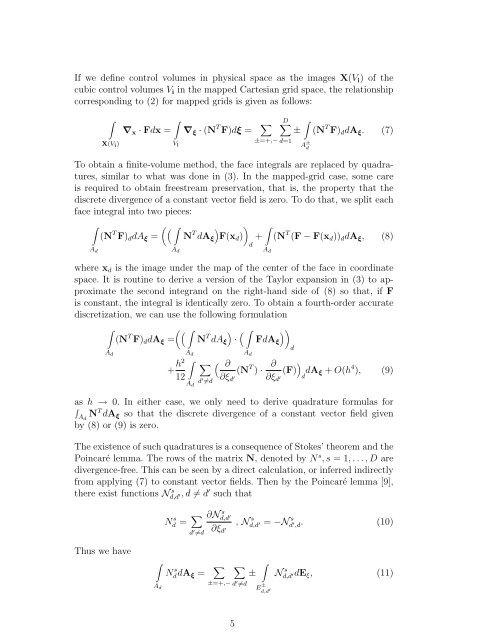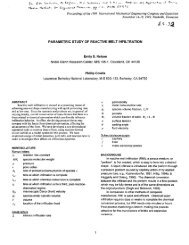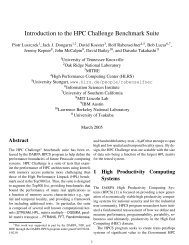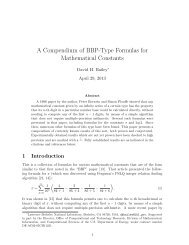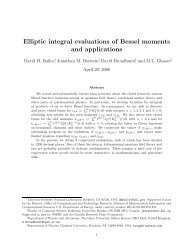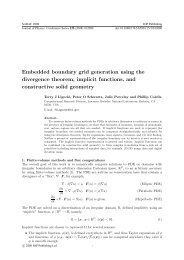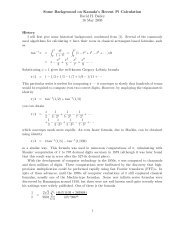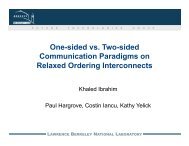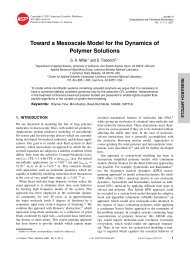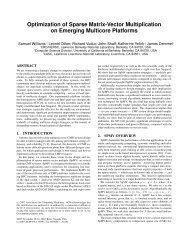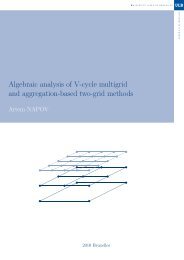High-Order, Finite-Volume Methods in Mapped Coordinates
High-Order, Finite-Volume Methods in Mapped Coordinates
High-Order, Finite-Volume Methods in Mapped Coordinates
Create successful ePaper yourself
Turn your PDF publications into a flip-book with our unique Google optimized e-Paper software.
If we def<strong>in</strong>e control volumes <strong>in</strong> physical space as the images X(V i ) of thecubic control volumes V i <strong>in</strong> the mapped Cartesian grid space, the relationshipcorrespond<strong>in</strong>g to (2) for mapped grids is given as follows:∫X(V i )∫∇ x · Fdx = ∇ ξ · (N T F)dξ = ∑ D∑∫±V±=+,− d=1iA ± d(N T F) d dA ξ . (7)To obta<strong>in</strong> a f<strong>in</strong>ite-volume method, the face <strong>in</strong>tegrals are replaced by quadratures,similar to what was done <strong>in</strong> (3). In the mapped-grid case, some careis required to obta<strong>in</strong> freestream preservation, that is, the property that thediscrete divergence of a constant vector field is zero. To do that, we split eachface <strong>in</strong>tegral <strong>in</strong>to two pieces:∫( ( ∫ ) )(N T F) d dA ξ = N T dA ξ F(xd )A d A dd∫+A d(N T (F − F(x d )) d dA ξ , (8)where x d is the image under the map of the center of the face <strong>in</strong> coord<strong>in</strong>atespace. It is rout<strong>in</strong>e to derive a version of the Taylor expansion <strong>in</strong> (3) to approximatethe second <strong>in</strong>tegrand on the right-hand side of (8) so that, if Fis constant, the <strong>in</strong>tegral is identically zero. To obta<strong>in</strong> a fourth-order accuratediscretization, we can use the follow<strong>in</strong>g formulation∫( ( ∫ ) ( ∫ ) )(N T F) d dA ξ = N T dA ξ · FdA ξdA d A d A d+ h2 ∫∑ ( ∂(N T ∂) · (F) ) 12 ∂ξ d ′ ∂ξ dA ξ + O(h 4 ), (9)d ′ dA dd ′ ≠das h → 0. In either case, we only need to derive quadrature formulas for∫A dN T dA ξ so that the discrete divergence of a constant vector field givenby (8) or (9) is zero.The existence of such quadratures is a consequence of Stokes’ theorem and thePo<strong>in</strong>caré lemma. The rows of the matrix N, denoted by N s , s = 1, . . . , D aredivergence-free. This can be seen by a direct calculation, or <strong>in</strong>ferred <strong>in</strong>directlyfrom apply<strong>in</strong>g (7) to constant vector fields. Then by the Po<strong>in</strong>caré lemma [9],there exist functions N s d,d ′, d ≠ d′ such thatN s d = ∑ d ′ ≠d∂N s d,d ′∂ξ d ′, N s d,d ′ = −N s d ′ ,d. (10)Thus we have∫NddA s ξ = ∑ ∑∫± Nd,d s ′dE ξ, (11)A±=+,− d ′ ≠dd E ± d,d ′5


